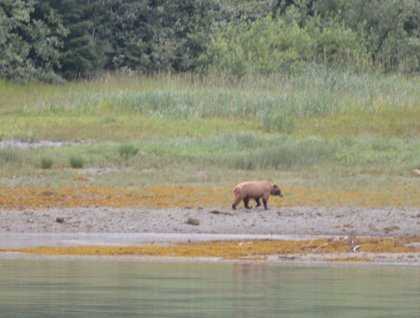We brake for bears and glaciers! Maybe that should be a bumper sticker here in Alaska.
There are few places in the world more inspiring than Glacier Bay National Park in Southeast Alaska, but here we were today, lucky to find ourselves in the legendary and beautiful home of many impressive glaciers, inlets, rock faces, and tall fog-shrouded peaks.
As we were slowly waking up around 6:30 a.m., keeping a watchful eye for wildlife, we passed a lone humpback whale and a sea otter as the ship made its way through Sitakaday Narrows at the entrance of Glacier Bay. Shortly after breakfast, now fully caffeinated and more alert, everyone stood at the bow excited about the wildlife that awaited us at South Marble Island. Hundreds of Steller sea lions on the island greeted us with their roar (and their unmistakable smell!). Soon after, we were surrounded by large numbers of black-legged kittiwakes, tufted puffins, pelagic cormorants, pigeon guillemots, marbled murrelets, and a few black oystercatchers and harlequin ducks. The vibrantly colored puffins—a life bird on many birders’ list—were perhaps everyone’s favorite, as we noted from everyone’s cameras employing rapid-fire shutter mode to capture the birds in flight.
As we traveled up Glacier Bay, we marveled at all the landscape and seascape features trying to imagine what a tremendous glacier filled this large bay just 250 years ago! We went into narrow Tidal Inlet and scanned the coast—all of a sudden, we saw two large brown bears foraging along the coast! With hushed whispers we “ooohed” and “aaahed,” as the bears overturned rocks looking for blenny fish, really just waiting for their feast to begin—the salmon to start returning to the stream! Later, we were lucky to get a good look at a foraging black bear in Geikie Inlet, too!
The greatest, most jaw-dropping spectacle of the day awaited us 65 miles in, at the top of Glacier Bay, just beyond Jaw Point—the Johns Hopkins Glacier! The most massive glacier we had seen all week, this one measured one mile in width and 250 feet in height, and it still stands as one of the few glaciers in the world that is growing rather than receding. The majestic glacier inspired us to think about how dynamic this environment is, how new landscapes are continuously crafted by glaciers, how history is always being made, and how these glaciers have been our windows to it. We will now keep the spirit of Southeast Alaska in our hearts forever. As Kim Heacox described Glacier Bay in “The Only Kayak”:
“Travel this country and you move through more than geography, you move through time. Trace your fingers over glacial striations in metamorphic rock. Stare into the fractured blue walls of the Ice Age, and you’ll find they’re not walls at all. They’re windows.”







